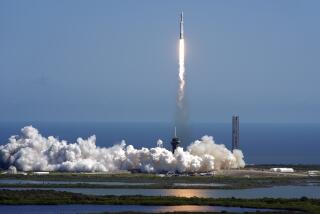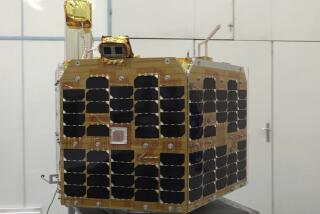NASA hails SpaceX launch as ‘a new era’ for spaceflight
In a pivotal moment for private spaceflight, a towering white rocket lifted a cone-shaped capsule into space early Tuesday on a mission to the International Space Station.
SpaceX’s Falcon 9 rocket carried the unmanned Dragon capsule into space after a 3:44 a.m. EDT launch from Cape Canaveral, Fla., marking the first time a private company has sent a spacecraft to the space station.
The mission is considered the first test of NASA’s plan to outsource space missions to privately funded companies now that its fleet of space shuttles is retired. SpaceX aims to prove to NASA that its Falcon 9 rocket and Dragon capsule are ready to take on the task of hauling cargo -- and eventually astronauts -- for the space agency.
INTERACTIVE: SpaceX’s demonstration mission
“Today marks the beginning of a new era in exploration; a private company has launched a spacecraft to the International Space Station that will attempt to dock there for the first time,” said NASA Administrator Charles Bolden in a speech at the cape. “And while there is a lot of work ahead to successfully complete this mission, we are certainly off to good start.”
In a separate news conference, Elon Musk, SpaceX’s 40-year-old billionaire founder and chief executive, spoke at company headquarters in Hawthorne. It was there that SpaceX employees had gathered, watched and cheered as the Falcon 9 climbed toward the heavens.
“There’s so much hope riding on that rocket,” he said. “When it worked ... and they saw their handiwork in space and operating as it should, there was tremendous elation. For us, it’s like winning the Super Bowl.”
But the launch is just the beginning, and the toughest tasks in the mission lie ahead.
The Dragon capsule will rendezvous with the space station as it circles the Earth at about 17,000 mph. Once the Dragon catches up to the station, it must complete a series of complicated tests to determine if it is ready to dock.
If all goes well, the crew aboard the station will snag the spacecraft with a robotic arm and lead it in. SpaceX hopes to dock the Dragon, which is designed to carry up to seven astronauts, as early as Friday.
After years of testing, NASA is hoping to turn the job of carrying cargo and crews over to private industry at a lower cost. Meanwhile, the agency will focus on deep-space missions to land probes on asteroids and Mars.
The agency has poured nearly $400 million in seed money into SpaceX in hopes that the company can one day complete routine missions to the space station. NASA is doling out $63 million to the Russians each time it wants to send an astronaut to the station.
SpaceX, formally known as Space Exploration Technologies Corp., is one of the leading contenders to carry astronauts for NASA one day. Company officials say cargo missions will yield valuable flight experience toward accomplishing this goal by 2015.
Still, the company has experienced repeated delays over the years. For instance, SpaceX planned to launch the current mission Saturday. The countdown was flawless until the last second, when the rocket engines briefly lit up and then went dark.
SpaceX said a flight computer detected an anomaly in one of the rocket’s nine engines and automatically shut down the launch sequence. Later that day, company engineers traced the problem to a faulty valve, and technicians fixed it within hours.
That made Tuesday’s launch all that more exciting for Musk, who said that when he saw the Falcon 9 finally lift off, “every bit of adrenaline in my body released at that point.”
Founded in 2002, SpaceX makes the Dragon and Falcon 9 at a sprawling facility in Hawthorne that once was used to assemble fuselage sections for Boeing 747s. The hardware is put on a big rig and trucked to Cape Canaveral for launches.
The company, with about 1,800 employees, has a $1.6-billion contract to haul cargo in 12 flights to the space station for NASA. If the current mission is successful, SpaceX will begin fulfilling the contract later this year.
SpaceX has now had three successful launches of the Falcon 9.
With Tuesday’s successful launch, the reusable Dragon became the first U.S.-made spacecraft to head to the space station since the space shuttle started flying more than 30 years ago.
“We’re at the dawn of a new era in space exploration,” Musk said. “There are no precedents for what we’re doing here.”
RELATED:
SpaceX: A new frontier for space travel
Aerospace manufacturer Rocketdyne is for sale
The space shuttle’s birthplace: A Southland legacy
Twitter.com/@wjhenn
More to Read
Inside the business of entertainment
The Wide Shot brings you news, analysis and insights on everything from streaming wars to production — and what it all means for the future.
You may occasionally receive promotional content from the Los Angeles Times.









